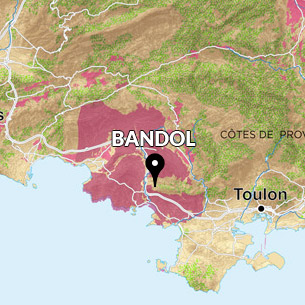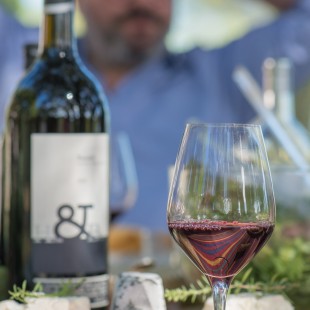Location: Between the Mediterranean Sea, the Sainte Baume mountain and the Mont Caume, Bandol vineyards are about 50 kilometers eastern the city of Marseille. Vines are perched on « restanques ».
Planted surface: 1500 hectares in production
Altitude: the vineyard is an amphitheatre enclosed between the moutains ; it stretches up to 450 meters in some places.
Red varieties: Mourvèdre, Grenache, Cinsault, Carignan, Syrah
Wine produced: white (5%), rosé (75%), red (20%)
The wine is achieved thanks to the unique freshness of tannins in the Mourvèdre here.
History of Bandol Vineyard
The viticultural tradition in Bandol goes back to the fifth century before our era when the Phoceens settled the Taurois colony. Later, the Romans discovered the surrounding vineyards of the area and develop them. Shortly, the wines from Bandol, previously named wines from Massilia (Marseille), became famous for their exceptional quality and their ability to age especially when shipped on boats. This was the moment when the wines started to be exported thanks to the harbour of Bandol facilities. Viticulture then became the cornerstone of the local business and the region started to be quite wealthy. In order to meet the expectations of the market, Bandol even became the so called « the 100 barrel workshops city ».
Unfortunately, this booming economy was stopped all of sudden when Phylloxera devastated Bandol as the rest of the French vineyards in 1870.
Thanks to a few pioneer winegrowers and thanks to their courage, the vineyard could be rebuilt. However the financial difficulties were due to the crisis, they favoured less productive grapes and planted Grenache, Cinsault but mostly Mourvèdre. They knew that here, Mourvèdre would find the best conditions to be cultivated, a clay soil with a stony sub soil, plenty of sea minerals. Their work was rewarded in 1941 when Bandol wines officially received the AOC (Appellation d’Origine Contrôlée) and were recognized among the greatest wines from France.
Terroir
However the appellation is tiny, it extends across eight villages: Bandol, Le Beausset, Le Castellet, La Cadière d’Azur, Saint Cyr sur Mer, Sainte Anne d’Evenos, Sanary and Ollioules.
As a legacy from the Crétacé era, on a large part of the AOC, a white and mineral soil is encountered. Whilst very poor, it is rich in limestones and siliceous fragments, sandy marls and sandstones are other components of this highly stony environment. On the other hand, the deep clay soils around La Cadière d’Azur reveal the most intense expression of Mourvèdre in Bandol.
The vineyard of Bandol is nowadays one of the last which is still planted on the famous « restanques ». These huge terraces of stones, handly built by the wine growers since several centuries to continue to cultivate vines on Bandol steep slopes.
Climatology
Nature has gathered in Bandol a combination of the best conditions to cultivate vine: nearly exclusively south oriented, the appellation benefits from 3000 sunny hours a year. Breezes coming from the sea but also the Mistral moderate these strong heats and preserve perfect sanitary conditions in the vineyard with an efficient grape drying process after rainfalls (total of 650mm per year).
Wines
We choose to express the Mourvèdre full power and depth, mainly through the wines coming from this magnificent terroir called Chemin de l’Argile, below the perched village La Cadière d’Azur. We blend them with some wines produced on the limestone area, northern Saint Cyr sur Mer. Freshness comes from the grapes harvested on the late ripening terroir of Sainte Anne d’Evenos; they bring a rythm and energy in this very sunny wine where we always search for the right balance. It is achieved thanks to the unique freshness of tannins in the Mourvèdre here.



